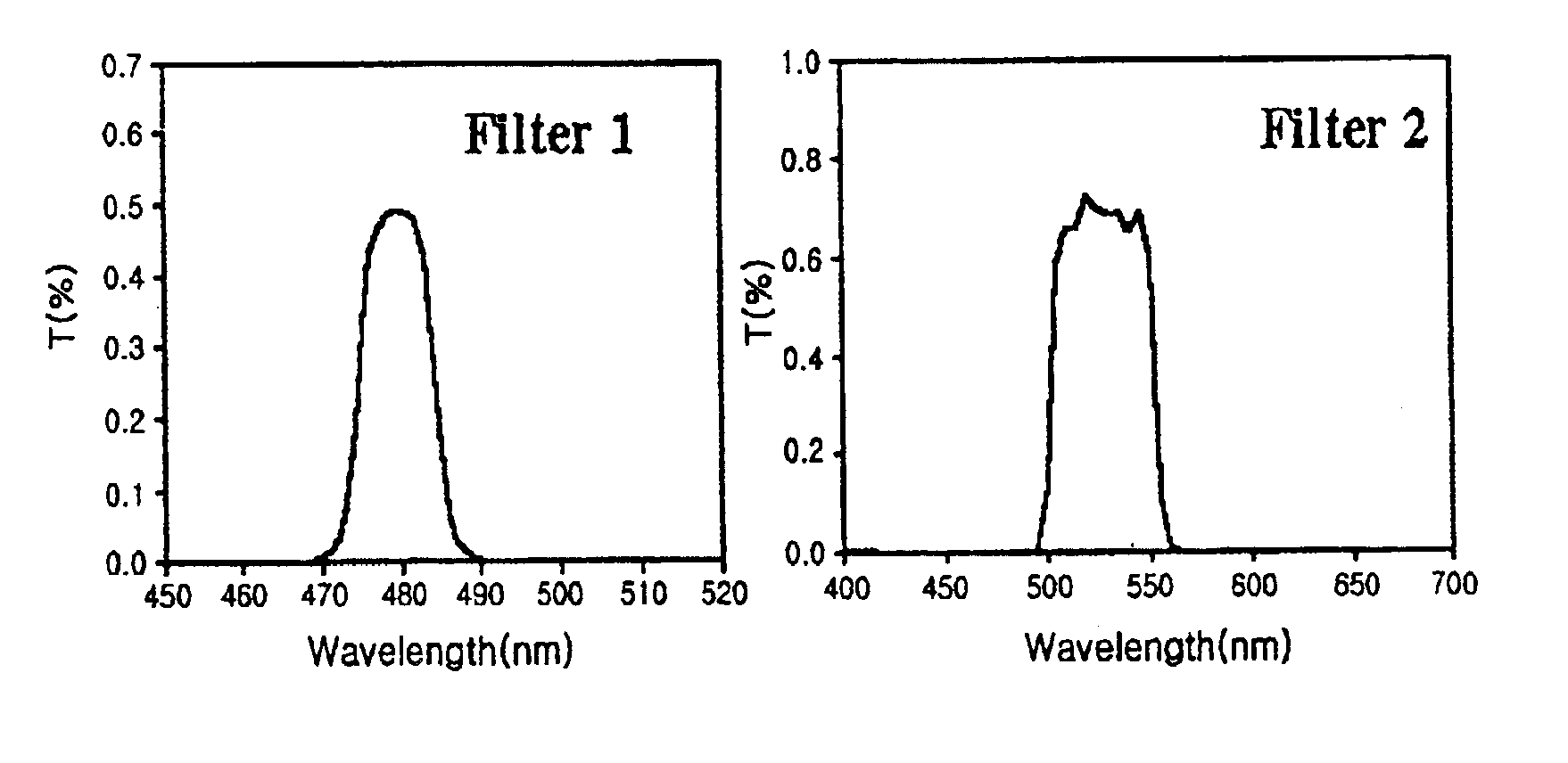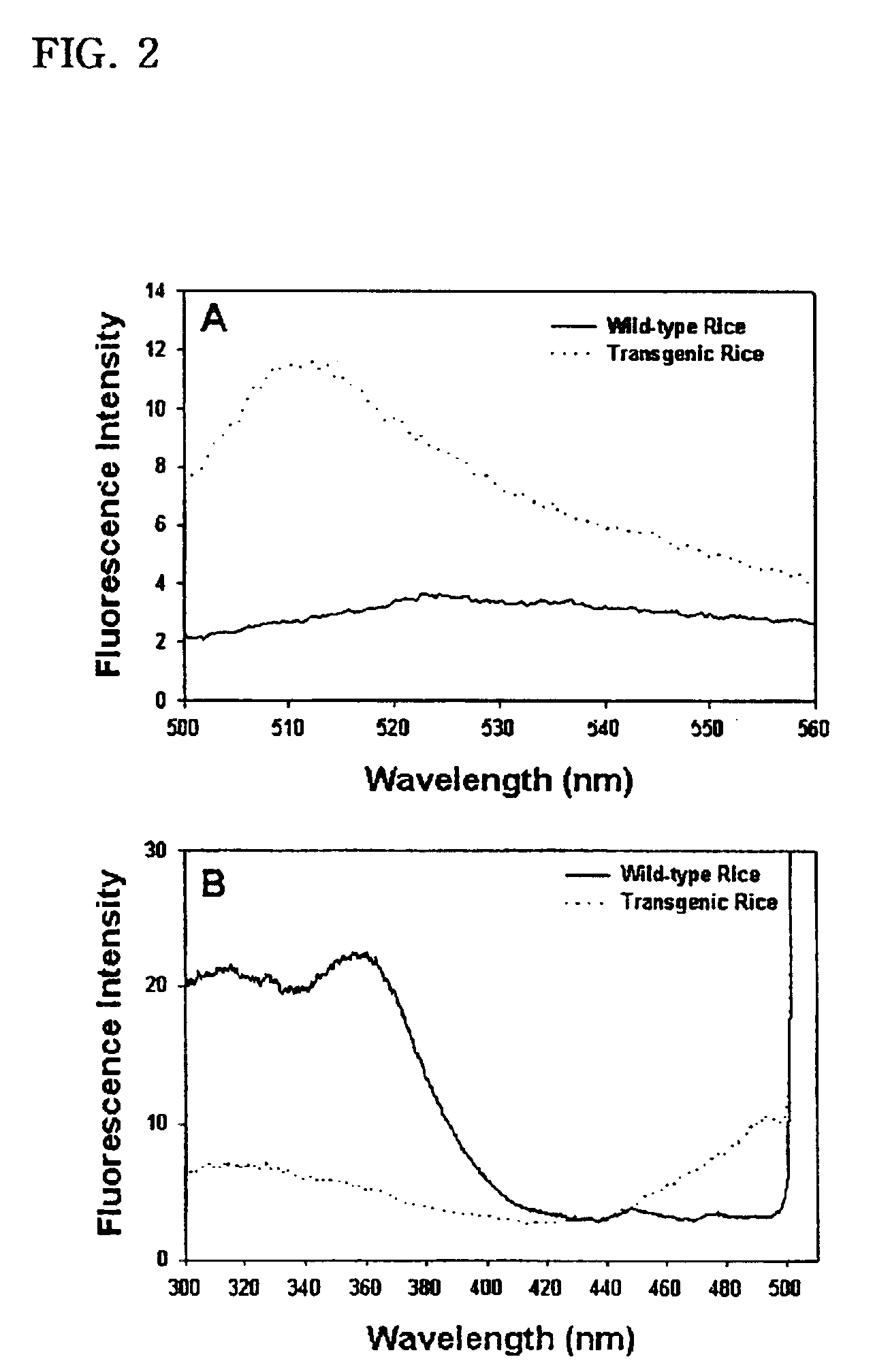Vivo monitoring method of transgenic plants and system using the same
a monitoring method and plant technology, applied in the field of transgenic plant monitoring methods and systems, can solve the problems of low light intensity of luc, difficult to directly observe the exogenous fluorescence of proteins introduced into plant tissues under fluorescent optical microscopes, and inconvenient direct visual selection of transgenic plants
- Summary
- Abstract
- Description
- Claims
- Application Information
AI Technical Summary
Benefits of technology
Problems solved by technology
Method used
Image
Examples
example 1
Construction of Vector
[0029]After being digested with BamHI and NcoI, a rice-derived Act1 promoter (McElroy D. et al., 1991, Mol. Gen. Genet. 231:150-160 was inserted into a BamHI / NcoI-linearized pBluescript plasmid containing an sgfp gene (Kohler R H. et al., 1997, Plant J. 11:613-621). Treatment of the resulting recombinant plasmid with BamHI and NotI extracted an Act1 promoter-sgfp fragment. This DNA fragment was ligated to a BamHI / NotI-linearized pSB105 that contained potato proteinase inhibitor II terminator / 35S promoter / bar / nopaline synthase terminator to construct a recombinant plasmid, named pSBG700, as illustrated in FIG. 1. Using the tripatental mating method disclosed in Komari T., et al., 1996, Plant J. 19:165-174), Agrobacterium tumefacience LBA4404 was transformed with the plasmid pSBG700.
example 2
Transformation of Rice
[0030]A wild-type rice seed (Oryza sativa cv. Nakdong) and a rice seed transformed with an agfp gene (Jang et al., 1999, Molecular breeding 5:453-461) were treated with 70% ethanol for 1 hour and then with 10% sodium hypochlorite for 15 min. After being washed five times with sterile water, the seeds were sowed in test tubes containing MS salt (Murashige T., Skoog F., 1962, Physiol. Plant, 15:473-497), sucrose 30 g / l, and bactoagar 8 g / l. Subsequently, the test tubes were incubated in a growth chamber which was adjusted to a temperature of 25° C. with a PFD maintained at 100 μmol m−2s−1. Under light-illuminated and shielded conditions, the seeds were let to grow for 16 hours and 8 hours, respectively. The seeds were germinated to white plants in the test tubes in the dark. In petri dishes containing MS salt, glucose 30 g / l, 2,4-D 2 mg / l, and bactoagar 8 g / l, calluses were induced from the white sprouts and grown at 25° C. in the growth chamber under the control...
example 3
GFP Fluorometry
[0032]To determine the excitation and emission spectra of the GFP that the transgenic plants produced, water-soluble proteins were extracted from leaves of the transgenic rice which had been grown for three months.
[0033]To this end, first, sliced leaves were homogenized in an extraction buffer (20 mM Tris-HCl, pH 8.0, 10 mM EDTA, 30 mM NaCl, 2 mM phenylmethanesulfonyl fluoride). After the centrifugation of the homogenate at 12,000×g for 10 min, a portion of the supernatant thus obtained was added to the extraction buffer to make a final volume of 1 ml. Using an assay kit (Bio-Rad) according to manufacturer's instruction, water-soluble proteins were quantitatively analyzed with bovine serum albumin serving as a control.
[0034]At room temperature, a quantitative measurement was made of the GFP fluorescence of cell extracts with the aid of an F-450 fluorometer (Hitachi, Japan) in 10 mm / 10 mm cuvettes. After passing through the excitation and emission monochromator used in...
PUM
| Property | Measurement | Unit |
|---|---|---|
| wavelength | aaaaa | aaaaa |
| wavelength | aaaaa | aaaaa |
| angle | aaaaa | aaaaa |
Abstract
Description
Claims
Application Information
 Login to View More
Login to View More - R&D
- Intellectual Property
- Life Sciences
- Materials
- Tech Scout
- Unparalleled Data Quality
- Higher Quality Content
- 60% Fewer Hallucinations
Browse by: Latest US Patents, China's latest patents, Technical Efficacy Thesaurus, Application Domain, Technology Topic, Popular Technical Reports.
© 2025 PatSnap. All rights reserved.Legal|Privacy policy|Modern Slavery Act Transparency Statement|Sitemap|About US| Contact US: help@patsnap.com



